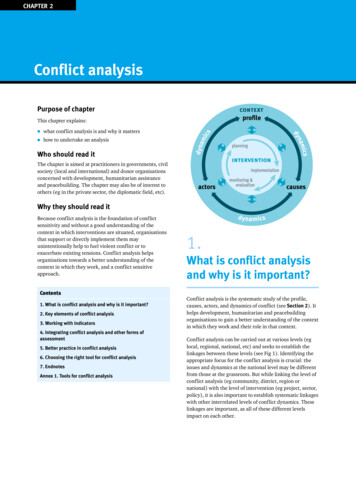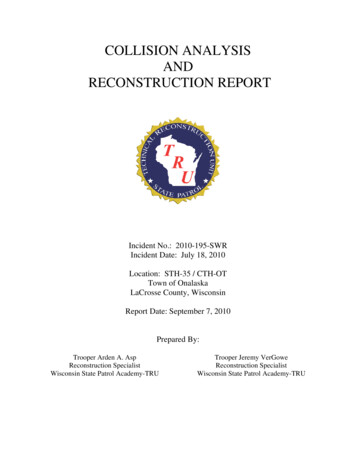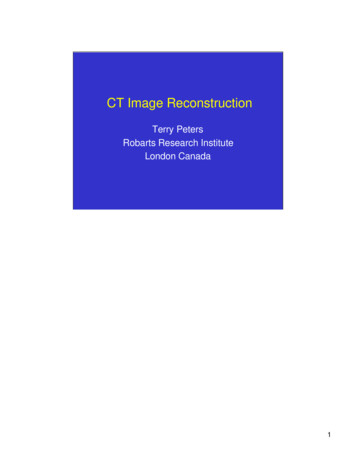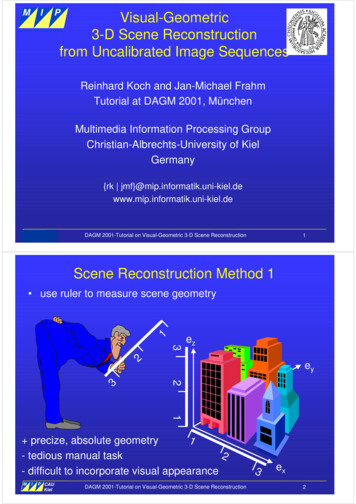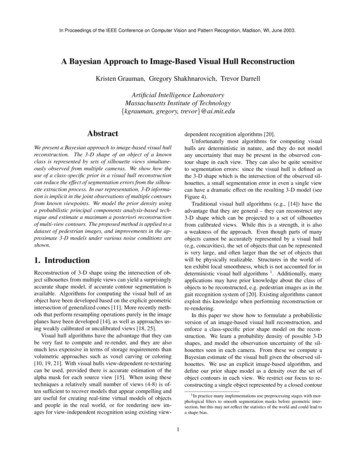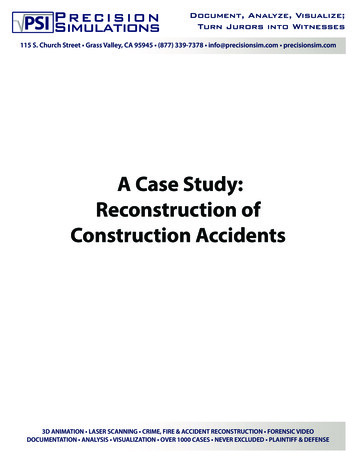
Transcription
POST CONFLICT RECONSTRUCTIONA Selected BibliographyCompiled by Jeanette M. MoyerU.S. Army War College LibraryCarlisle Barracks, PAJanuary 2007PREFACEAmerican military, diplomatic, and humanitarian personnel continue to participate in postconflict reconstruction efforts around the world. This selected bibliography lists references for readings about post-conflict reconstruction in general, as well as describing the aftermath of war in thefollowing countries: Afghanistan, Bosnia, Haiti, Iraq, Kosovo, and Somalia.With the exception of some important older titles, most of the books, documents, articles andonline resources cited are dated 2003 to the present. All items in this bibliography are available inthe USAWC Library. For your convenience, at the end of the entries, we have added library callnumbers, Internet addresses, or database links. Call numbers indicate the item’s shelf location in ourlibrary, please note that call numbers can vary from library to library. Web sites were accessed during January 2007.This bibliography and others, compiled by our research librarians, are available onlinethrough the Library's home page s.htm.For additional information, please contact the Research and Information Services Branch,U.S. Army War College Library by sending an e-mail message to libraryr@carlisle.army.mil, or byphoning DSN 242-3660 or Commercial (717) 245-3660.Jeanette M. Moyer, compileri
Form ApprovedOMB No. 0704-0188Report Documentation PagePublic reporting burden for the collection of information is estimated to average 1 hour per response, including the time for reviewing instructions, searching existing data sources, gathering andmaintaining the data needed, and completing and reviewing the collection of information. Send comments regarding this burden estimate or any other aspect of this collection of information,including suggestions for reducing this burden, to Washington Headquarters Services, Directorate for Information Operations and Reports, 1215 Jefferson Davis Highway, Suite 1204, ArlingtonVA 22202-4302. Respondents should be aware that notwithstanding any other provision of law, no person shall be subject to a penalty for failing to comply with a collection of information if itdoes not display a currently valid OMB control number.1. REPORT DATE2. REPORT TYPE15 JAN 2007Bibliography3. DATES COVERED01-01-2007 to 31-01-20074. TITLE AND SUBTITLE5a. CONTRACT NUMBERPost Conflict Reconstruction A Selected Bibliography5b. GRANT NUMBER5c. PROGRAM ELEMENT NUMBER6. AUTHOR(S)5d. PROJECT NUMBERJeanette Moyer5e. TASK NUMBER5f. WORK UNIT NUMBER7. PERFORMING ORGANIZATION NAME(S) AND ADDRESS(ES)U.S. Army War College,Carlisle Barracks,Carlisle,PA,17013-50509. SPONSORING/MONITORING AGENCY NAME(S) AND ADDRESS(ES)8. PERFORMING ORGANIZATIONREPORT NUMBER10. SPONSOR/MONITOR’S ACRONYM(S)11. SPONSOR/MONITOR’S REPORTNUMBER(S)12. DISTRIBUTION/AVAILABILITY STATEMENTApproved for public release; distribution unlimited13. SUPPLEMENTARY NOTES14. ABSTRACTSee attached.15. SUBJECT TERMS16. SECURITY CLASSIFICATION OF:17. LIMITATIONOF ABSTRACTa. REPORTb. ABSTRACTc. THIS PAGEunclassifiedunclassifiedunclassified18. NUMBEROF PAGES19a. NAME OFRESPONSIBLE PERSON26Standard Form 298 (Rev. 8-98)Prescribed by ANSI Std Z39-18
POST CONFLICT RECONSTRUCTIONA Selected BibliographyJanuary 2007ContentsGeneral Information . 1Afghanistan. 7Bosnia . 11Haiti. 13Iraq . 15Kosovo . 21Somalia . 23iii
GENERAL INFORMATIONBooks, Documents, and Internet ResourcesAzimi, Nassrine, and Chang Li Lin, eds. United Nations as Peacekeeper and Nation-Builder: Continuity and Change: What Lies Ahead? Report of the 2005 Hiroshima Conference, United Nations Institute for Training and Research (UNITAR), and Institute of Policy Studies (IPS) ofSingapore. Boston: M. Nijhoff, 2006. 250pp. (JZ6374 .U537 2006)Barakat, Sultan, ed. After the Conflict: Reconstruction and Development in the Aftermath of War.New York: Palgrave Macmillan, 2005. 313pp. (HV639 .A27 2005)Barsalou, Judy. Trauma and Transitional Justice in Divided Societies. Washington, D.C.: UnitedStates Institute of Peace, 2005. 11pp. (JZ5584 .U6SR no.135) innendijk, Hans, and Stuart E. Johnson, eds. Transforming for Stabilization and ReconstructionOperations. Washington, D.C.: National Defense University Press, 2004. 134pp. (UH723 .T732004)Bullimore, Steven L. The Military’s Role in Nation-Building: Peace and Stability Operations Redefined. Strategy Research Project. Carlisle Barracks: U.S. Army War College, 2006. (AD-A448657) 18pp. http://handle.dtic.mil/100.2/ADA448657Bush, George W. Management of Interagency Efforts Concerning Reconstruction and Stabilization.National Security Presidential Directive / NSPD-44. Washington, D.C.: The White House, 7December 2005. 6pp. rafano, James J. Post-Conflict Operations from Europe to Iraq. Washington, D.C.: HeritageFoundation, 2004. 9pp. (HD87 .H26 no.844) hl844.cfmCarafano, James J., and Dana R. Dillon. Winning the Peace: Principles for Post-Conflict Operations. Washington, D.C.: Heritage Foundation, 2005. 10pp. cfmClover, Jenny, and Richard Cornwell, eds. Supporting Sustainable Livelihoods: A Critical Review ofAssistance in Post-Conflict Situations. Pretoria, South Africa: Institute for Security Studies,2004. 107pp. (JZ4835 .I76 no.102)Cohen, Craig. Measuring Progress in Stabilization and Reconstruction. Washington, D.C.: UnitedStates Institute of Peace, 2006. 15pp. (JZ5584 .U6SRS no.1) dfConaway, Camille Pampell. The Role of Women in Stabilization and Reconstruction. Washington,D.C.: United States Institute of Peace, 2006. 24pp. (JZ5584 .U6SRS no.3) http://www.usip.org/pubs/specialreports/srs/sr sthree.pdf
Council on Foreign Relations. In the Wake of War: Improving U.S. Post-Conflict Capabilities. Report of an Independent Task Force sponsored by the Council on Foreign Relations. Samuel R.Berger and Brent Scowcroft, Project Co-Chairs; William L. Nash, Project Director. New York:Council on Foreign Relations, 2005. 53pp. (JZ6300 .I5 2005) s/PostConflict Capabilities final.pdfCovey, Jock, Michael J. Dziedzic, and Leonard R. Hawley, eds. The Quest for Viable Peace: International Intervention and Strategies for Conflict Transformation. Washington, D.C.: UnitedStates Institute of Peace Press, 2005. 302pp. (JZ5538 .Q47 2005)Crocker, Bathsheba, et al. “Rethinking and Rebuilding the Relationship between War and Policy:Post-Conflict Reconstruction.” In Rethinking the Principles of War, ed. Anthony D. McIvor,360-387. Annapolis: Naval Institute Press, 2005. (U102 .R48 2005)DeGrasse, Beth Cole, and Christina Caan. Transitional Governance: From Bullets to Ballots.Washington, D.C.: United States Institute of Peace, 2006. 23pp. (JZ5584 .U6SRS r stwo.pdfDobbins, James, et al. America’s Role in Nation-Building: From Germany to Iraq. Santa Monica:RAND, 2003. 244pp. (E840 .A639 2003) , James, et al. The UN's Role in Nation-Building: From the Congo to Iraq. Santa Monica:RAND, 2005. 273pp. (JZ4984.5 .U531 2005) http://www.rand.org/pubs/monographs/2005/RAND MG304.pdfEllsworth, James B. SysAdmin: Toward Barnett's Stabilization and Reconstruction Force. Arlington: Association of the United States Army, Institute of Land Warfare, 2006. 14pp. (UA23.A95L16 no.57) http://www.ausa.org/PDFdocs/LWPapers/LWP 57.pdfFukuyama, Francis, ed. Nation-Building: Beyond Afghanistan and Iraq. Baltimore: Johns HopkinsUniversity Press, 2006. 262pp. (JZ6300 .N17 2006)Hamre, John J. Civilian Post-Conflict Reconstruction Capabilities. Testimony before the Committee on Foreign Relations, United States Senate. Washington, D.C.: Center for Strategic and International Studies, 3 March 2004. 9pp. mre.pdfJennings, Ray Salvatore. The Road Ahead: Lessons in Nation Building from Japan, Germany, andAfghanistan for Postwar Iraq. Washington, D.C.: United States Institute of Peace, 2003. 43pp.(JZ5584 .U6P43 no.49) g, Ho-Won. Peacebuilding in Postconflict Societies: Strategy and Process. Boulder: Lynne Rienner, 2005. 255pp. (JZ5538 .J25 2005)Jones, Seth G., et al. Establishing Law and Order after Conflict. Santa Monica: RAND, 2005.261pp. (HV7921 .E88 2005) www.rand.org/pubs/monographs/2005/RAND MG374.pdf2
Jones, Seth G., et al. Securing Health: Lessons from Nation-Building Missions. Santa Monica:RAND, 2006. 351pp. (RA390 .A2S21 2006) http://www.rand.org/pubs/monographs/2006/RAND MG321.pdfJunne, Gerd, and Willemijn Verkoren, eds. Postconflict Development: Meeting New Challenges.Boulder: Lynne Rienner, 2005. 371pp. (HV639 .P57 2005)Kelly, Terrence K. Options for Transitional Security Capabilities for America. Santa Monica:RAND, 2006. 48pp. (UB825 .U54K24 2006) http://www.rand.org/pubs/technical reports/2006/RAND TR353.pdfLogan, Justin, and Christopher Preble. Failed States and Flawed Logic: The Case against a Standing Nation-Building Office. Washington, D.C.: CATO Institute, 11 January 2006. 32pp. http://cato.org/pubs/pas/pa560.pdfMertus, Julie, and Tazreena Sajjad. “When Civil Society Promotion Fails State-Building: The Inevitable Fault-Lines in Post-Conflict Reconstruction.” In Subcontracting Peace: The Challenges ofNGO Peacebuilding, ed. Oliver P. Richmond and Henry F. Carey, 119-130. Burlington: Ashgate, 2005. (JZ5538 .S71 2005)Montgomery, John D., and Dennis A. Rondinelli, eds. Beyond Reconstruction in Afghanistan: Lessons from Development Experience. New York: Palgrave Macmillan, 2004. 245pp. (HC417.B29 2004)Murray, Williamson, ed. A Nation at War in an Era of Strategic Change. Carlisle Barracks: U.S.Army War College, Strategic Studies Institute, 2004. 371pp. (U413 .A66N18 2004) http://handle.dtic.mil/100.2/ADA427801Orr, Robert C., ed. Winning the Peace: An American Strategy for Post-Conflict Reconstruction.Washington, D.C.: CSIS Press, 2004. 353pp. (E895 .W56 2004)Perito, Robert M. Where Is the Lone Ranger When We Need Him?: America's Search for a Postconflict Stability Force. Washington, D.C.: United States Institute of Peace Press, 2004. 397pp.(JZ6377 .U6P475 2004)Robbins, Matthew J. Investigating the Complexities of Nationbuilding: A Sub-National RegionalPerspective. Wright Patterson Air Force Base: Air Force Institute of Technology, 2005. , Philip G., and Donald Rothchild, eds. Sustainable Peace: Power and Democracy after CivilWars. Ithaca, NY: Cornell University Press, 2005. 383pp. (JZ5538 .S76 2005)Rotberg, Robert I., ed. When States Fail: Causes and Consequences. Princeton: Princeton University Press, 2004. 335pp. (JF60 .W32 2004)Schnabel, Albrecht, and Hans-Georg Ehrhart, eds. Security Sector Reform and Post-Conflict Peacebuilding. New York: United Nations University Press, 2005. 329pp. (UA10.5 .S22 2005)3
Serafino, Nina M., and Martin A. Weiss. Peacekeeping and Post-Conflict Capabilities: The StateDepartment’s Office for Reconstruction and Stabilization. Washington, D.C.: Library of Congress, Congressional Research Service, 19 January 2005. 6pp. http://www.opencrs.com/getfile.php?rid 37409Shope, Virginia C., comp. Peacekeeping: A Selected Bibliography. Carlisle Barracks: U.S. ArmyWar College Library, 2004. 32pp. (U413 .Z92P4 2004) htmShope, Virginia C., comp. Post-Conflict Reconstruction: A Selected Bibliography. Carlisle Barracks: U.S. Army War College Library, 2003. 32pp. (U413 .Z92P67 2003) htmSomit, Albert, and Steven A. Peterson. The Failure of Democratic Nation Building: Ideology MeetsEvolution. New York: Palgrave Macmillan, 2005. 159pp. (JC423 .S55 2005)U.S. Army Peacekeeping and Stability Operations Institute. Infrastructure Reconstruction: Imperative in the National Interest: Final Report. Carlisle Barracks: U.S. Army War College, U.S.Army Peacekeeping and Stability Operations Institute, 2006. 40pp. (U413 .P2D68 2006)U.S. Department of Defense. Military Support for Stability, Security, Transition, and Reconstruction (SSTR) Operations. DoD Directive 3000.05. Washington, D.C.: U.S. Department of Defense, 28 November 2005. 11pp. (DOD 3000.05 (D)) 05 112805/300005p.pdfU.S. Department of State. Post Conflict Reconstruction Essentials Tasks Matrix. Washington, D.C.:U.S. Department of State, Office of the Coordinator for Reconstruction and Stabilization, 2005.54pp. http://www.state.gov/s/crs/rls/52959.htmU.S. Joint Forces Command. Military Support to Stabilization, Security, Transition, and Reconstruction Operations Joint Operating Concept (JOC). Suffolk, VA: U.S. Joint Forces Command, 2006. 45pp. (U260 .J741 2006) tro joc v10.docWang, Gungwu, ed. Nation-Building: Five Southeast Asian Histories. Singapore: Institute of Southeast Asian Studies, 2005. 288pp. (DS526.7 .N38 2005)Williams, Garland H. Engineering Peace: The Military Role in Postconflict Reconstruction. Washington, D.C.: United States Institute of Peace Press, 2005. 317pp. (JZ6377 .U6W34 2005)Williams, Garland H. “A Postconflict Reconstruction Template.” In Engineering Peace: The Military Role in Postconflict Reconstruction, 217-268. Washington, D.C.: United States Institute ofPeace Press, 2005. (JZ6377 .U6W34 2005)World Bank. Reshaping the Future: Education and Postconflict Reconstruction. Washington, D.C.:World Bank, 2005. 93pp. (JZ5538 .R27 2005) http://www1.worldbank.org/education/pdf/Reshaping the Future.pdf4
Periodical ArticlesAnderson, George E., III. “Winning the Nationbuilding War.” Military Review 84 (SeptemberOctober 2004): 47-50. ProQuestBarakat, Sultan, Margaret Chard, and Richard Jones. “Attributing Value: Evaluating Success andFailure in Post-War Reconstruction.” Third World Quarterly 26 (June 2005): 831-852. Taylor &FrancisBarnett, Michael. “Building a Republican Peace: Stabilizing States after War.” International Security 30 (Spring 2006): 87-112. MIT PressBello, Walden. “The Rise of the Relief and Reconstruction Complex.” Journal of International Affairs 59 (Spring 2006): 281-298. ProQuestBhatia, Michael. “Postconflict Profit: The Political Economy of Intervention.” Global Governance11 (April-June 2005): 205-225. ProQuestBronson, Rachael. “Reconstructing the Middle East?” Brown Journal of World Affairs 10 (SummerFall 2003): 271-280. ssays/Bronson.pdfBrzoska, Michael. “Introduction: Criteria for Evaluating Post-Conflict Reconstruction and SecuritySector Reform in Peace Support Operations.” International Peacekeeping 13 (March 2006): 113. Taylor & Francis“Building Democracy after Conflict.” Seven articles. Journal of Democracy 16 (January 2005): 588. ProQuestChandler, David. “The Problems of ‘Nation-Building’: Imposing Bureaucratic ‘Rule from Above’.”Cambridge Review of International Affairs 17 (October 2004): 576-591. Taylor & FrancisChesterman, Simon. “Bush, the United Nations and Nation-Building.” Survival 46 (Spring 2004):101-116. Taylor & FrancisCoyne, Christopher J. “Reconstructing Weak and Failed States.” Journal of Social, Political andEconomic Studies 31 (Summer 2006): 143-162.Dobbins, James. “America’s Role in Nation Building: From Germany to Iraq.” Survival 45 (December 2003): 87-109. Taylor & FrancisDobbins, James. “NATO’s Role in Nation-Building.” NATO Review, no. 2 (Summer 2005) h/art1.htmlDobbins, James. “Preparing for Nation-Building.” Survival 48 (October 2006): 27-40. Taylor &FrancisDobbins, James. “The UN’s Role in Nation-Building: From the Belgian Congo to Iraq.” Survival 46(December 2004): 81-102. Taylor & Francis5
Donahoe, Patrick J. “Preparing Leaders for Nationbuilding.” Military Review 84 (May-June 2004):24-26. ProQuestEdelstein, David M. “Occupational Hazards: Why Military Occupations Succeed or Fail.” International Security 29 (Summer 2004): 49-91. MIT PressEizenstat, Stuart, John Edward Porter, and Jeremy Weinstein. “Rebuilding Weak States.” ForeignAffairs 84 (January-February 2005): 134-146. ProQuestEtzioni, Amitai. “A Self-Restrained Approach to Nation-Building by Foreign Powers.” International Affairs 80 (January 2004): 1-17.“From Nation-Building to State-Building.” Special issue. Third World Quarterly 27 (February2006): entire issue. Taylor & FrancisFukuyama, Francis. “Nation Building 101.” Atlantic Monthly 293 (January-February 2004): 159162. ProQuestGilbert, Marc Jason. “Fatal Amnesia: American Nation-Building in Vietnam, Afghanistan andIraq.” Journal of Third World Studies 21 (Fall 2004): 13-43. ProQuestGuttal, Shalmali. “The Politics of Post-War / Post-Conflict Reconstruction.” Development 48 (September 2005): 73-81. ProQuestIasiello, Louis V. “Jus Post Bellum.” Naval War College Review 57 (Summer 2004): 33-50.ProQuestJones, Seth G., and James Dobbins. “The UN's Record in Nation Building.” Chicago Journal of International Law 6 (Winter 2006): 703-724. ProQuestKang, Seonjou, and James Meernik. “Determinants of Post-Conflict Economic Assistance.” Journalof Peace Research 41 (March 2004): 149-166.Klinger, Janeen. “Stabilization Operations and Nation-Building: Lessons from United NationsPeacekeeping in the Congo, 1960-1964.” Fletcher Forum of World Affairs 29 (Summer 2005):83-101.Krebs, Ronald R. “A School for the Nation?: How Military Service Does Not Build Nations, andHow It Might.” International Security 28 (Spring 2004): 85-124. MIT PressLaw, David M. “Conclusion: Security Sector (Re)Construction in Post-Conflict Settings.” International Peacekeeping 13 (March 2006): 111-123. Taylor & FrancisMaley, William. “Democratic Governance and Post-Conflict Transitions.” Chicago Journal of International Law 6 (Winter 2006): 683-702. ProQuestMcMahon, Robert. “Seeking a Patient Path to Nationbuilding.” Foreign Service Journal 83 (November 2006): 22-29.6
Montgomery, John D., and Dennis A. Rondinelli. “A Path to Reconstruction.” Harvard International Review 26 (Summer 2004): 26-30. ProQuestMuggah, Robert. “No Magic Bullet: A Critical Perspective on Disarmament, Demobilization andReintegration (DDR) and Weapons Reduction in Post-Conflict Contexts.” Round Table 379(April 2005): 239-252.Natsios, Andrew S. “The Nine Principles of Reconstruction and Development.” Parameters 35(Autumn 2005): 4-21. ProQuestRondinelli, Dennis A., and John D. Montgomery. “Does the U.S. Need a Nation-Building Agency?”Foreign Service Journal 81 (December 2004): 56-60.Schadlow, Nadia. “Root’s Rules: Lessons from America's Colonial Office.” American Interest 2(January-February 2007): 92-102.Shinseki, Eric K. “The Security Challenges Facing Post-Conflict Democracies.” Georgia Journal ofInternational and Comparative Law 33 (Fall 2004): 143-155. Wilson OmniFile“Special Section on Post-Conflict Peacebuilding: Security, Welfare and Representation.” Seven articles. Security Dialogue 36 (December 2005): 427-526.Stratman, Henry W. “Orchestrating Instruments of Power for Nationbuilding.” Joint Force Quarterly, no. 41 (2d Quarter 2006): 32-37. ProQuestTalentino, Andrea K. “The Two Faces of Nation-Building: Developing Function and Identity.”Cambridge Review of International Affairs 17 (October 2004): 557-575. Taylor & FrancisToomey, Christopher J. “Winning the Economic Firefight: Translating Reconstruction into CombatPower.” Engineer 36 (April-June 2006): 20-23. ProQuestVan Gennip, Jos. “Post-Conflict Reconstruction and Development.” Development 48 (September2005): 57-62. ProQuestWilliams, Andrew J. “Reconstruction before the Marshall Plan.” Review of International Studies 31(July 2005): 541-558. CambridgeWood, William B. “Post-Conflict Intervention Revisited: Relief, Reconstruction, Rehabilitation, andReform.” Fletcher Forum of World Affairs 29 (Winter 2005): 119-132.AFGHANISTANBooks, Documents, and Internet ResourcesBarakat, Sultan, ed. Reconstructing War-Torn Societies: Afghanistan. New York: Palgrave Macmillan, 2004. 203pp. (HC417 .R21 2004)7
Cordesman, Anthony H. The “Post Conflict” Lessons of Iraq and Afghanistan: Testimony to theSenate Foreign Relations Committee. Washington, D.C.: Center for Strategic and InternationalStudies, 2004. 21pp. (DS79.769 .C671 2004) rdesman.pdfCourtney, Morgan L., et al. In the Balance: Measuring Progress in Afghanistan. CSIS PostReconstruction Project Report. Frederick Barton and Bathsheba Crocker, Co-Directors. Washington, D.C.: Center for Strategic and International Studies, 2005. 122pp. (DS371.4 .C58 nce.pdfDobbins, James, et al. “Afghanistan.” In America’s Role in Nation-Building: From Germany toIraq, 129-148. Santa Monica: RAND, 2003. (E840 .A639 2003) http://www.rand.org/publications/MR/MR1753/Donini, Antonio, Norah Niland, and Karin Wermester, eds. Nation-Building Unraveled?: Aid,Peace and Justice in Afghanistan. Bloomfield, CT: Kumarian Press, 2004. 236pp. (HV555.A3N17 2004)Dziedzic, Michael J., and Michael K. Seidl. Provincial Reconstruction Teams and Military Relations with International and Nongovernmental Organizations in Afghanistan. Washington,D.C.: United States Institute of Peace, 2005. 15pp. (JZ5584 .U6SR no.147) Fukuyama, Francis, ed. Nation-Building: Beyond Afghanistan and Iraq. Baltimore: Johns HopkinsUniversity Press, 2006. 262pp. (JZ6300 .N17 2006)International Crisis Group. Rebuilding the Afghan State: The European Union’s Role. Brussels,Belgium: International Crisis Group, 2005. 26pp. (JZ5595 .I21 no.107) http://www.crisisgroup.org/home/getfile.cfm?id 2061&tid 3803&type pdf&l 1Jones, Seth G., et al. “Afghanistan.” In Establishing Law and Order after Conflict, 61-104. SantaMonica: RAND, 2005. (HV7921 .E88 2005) http://www.rand.org/pubs/monographs/2005/RAND MG374.pdfJones, Seth G., et al. “Afghanistan.” In Securing Health: Lessons from Nation-Building Missions,187-219. Santa Monica: RAND, 2006. (RA390 .A2S21 2006) http://www.rand.org/pubs/monographs/2006/RAND MG321.pdfJones, Seth G, et al. “Afghanistan.” In Securing Tyrants or Fostering Reform?: U.S. Internal Security Assistance to Repressive and Transitioning Regimes, 89-124. Santa Monica: RAND, National Security Research Division, 2006. (UA12 .S21 2006) http://www.rand.org/pubs/monographs/2006/RAND MG550.pdfKatzman, Kenneth. Afghanistan: Post-War Governance, Security, and U.S. Policy. Washington,D.C.: Library of Congress, Congressional Research Service, 11 January 2007. 56pp. pdf8
Linder, Rebecca. Voices of a New Afghanistan. Washington, D.C.: Center for Strategic and International Studies, Post-Conflict Reconstruction Project, 2005. 23pp. (DS371.4 .L35 2005) ll, A. Phased Withdrawal, Conflict Resolution and State Reconstruction. Camberley, Surrey:Defence Academy of the United Kingdom, Conflict Studies Research Centre, 2006. 14pp.(U520 .R1 2006 no.29) /06(29)AM.pdfMillen, Raymond A. Afghanistan: Reconstituting a Collapsed State. Carlisle Barracks: U.S. ArmyWar College, Strategic Studies Institute, 2005. 22pp. (U413 .A66M344 2005) http://handle.dtic.mil/100.2/ADA432126Montgomery, John D., and Dennis A. Rondinelli, eds. Beyond Reconstruction in Afghanistan: Lessons from Development Experience. New York: Palgrave Macmillan, 2004. 245pp. (HC417.B29 2004)Perito, Robert M. “Nation Building: Biting the Bullet in Afghanistan and Iraq.” In Where Is theLone Ranger When We Need Him?: America’s Search for a Postconflict Stability Force, 323338. Washington, D.C.: United States Institute of Peace Press, 2004. (JZ6377 .U6P475 2004)Perito, Robert M. The U.S. Experience with Provincial Reconstruction Teams in Afghanistan: Lessons Identified. Washington, D.C.: United States Institute of Peace, 2005. 15pp. (JZ5584 .U6SR no.152) U.S. General Accountability Office. Afghanistan Reconstruction: Despite Some Progress, Deteriorating Security and Other Obstacles Continue to Threaten Achievement of U.S. Goals. Washington, D.C.: U.S. General Accountability Office, July 2005. 90pp. http://www.gao.gov/new.items/d05742.pdfVaishnav, Milan. “Afghanistan the Chimera of the ‘Light Footprint’.” In Winning the Peace: AnAmerican Strategy for Post-Conflict Reconstruction, ed. Robert C. Orr, 244-262. Washington,D.C.: CSIS Press, 2004. (E895 .W56 2004)Williams, Garland H. “Afghanistan.” In Engineering Peace: The Military Role in Postconflict Reconstruction, 173-216. Washington, D.C.: United States Institute of Peace Press, 2005. (JZ6377.U6W34 2005)Periodical ArticlesAhmad, Khabir. “Aiding the Aiders.” Lancet 364 (9-15 October 2004): 1303-1305. ProQuestAhmad, Khabir. “Health and Money in Afghanistan.” Lancet 364 (9-15 October 2004): 1301-1303.ProQuestDreyer, Vincent M. “Retooling the Nationbuilding Strategy in Afghanistan.” Joint Force Quarterly,no. 43 (4th Quarter 2006): 34-39. ProQuest9
Ghufran, Nasreen. “Afghanistan in 2005: The Challenges of Reconstruction.” Asian Survey 46(January-February 2006): 85-94. ProQuestGoodhand, Jonathan. “From War Economy to Peace Economy? Reconstruction and State Buildingin Afghanistan.” Journal of International Affairs 58 (Fall 2004): 155-175. ProQuestGoodson, Larry. “Afghanistan in 2003: The Taliban Resurface and a New Constitution Is Born.”Asian Survey 44 (January-February 2004): 14-22. ProQuestGoodson, Larry. “Afghanistan in 2004: Electoral Progress and an Opium Boom.” Asian Survey 45(January-February 2005): 88-97. ProQuestGoodson, Larry. “Bullets, Ballots, and Poppies in Afghanistan.” Journal of Democracy 16 (January2005): 24-39. ProQuestJawab, Said Tayeb. “Rebuilding Afghanistan: An Interview with H.E. (His Excellency) Ambassador Said Tayeb Jawad.” International Affairs Review 15 (Spring-Summer 2006): 7-12.Johnson, Thomas H. “Afghanistan's Post-Taliban Transition: The State of State-Building afterWar.” Central Asian Survey 25 (March-June 2006): 1-26. Taylor & FrancisKhalilzad, Zalmay. “How to Nation-Build: Ten Lessons from Afghanistan.” National Interest, no.80 (Summer 2005): 19-27. ProQuestKomano, Kinichi. “The Role of Elections in the Peace-Building and Reconstruction of Afghanistan.” Asia-Pacific Review 12 (May 2005): 1-16. Taylor & FrancisMcNerney, Michael J. “Stabilization and Reconstruction in Afghanistan: Are PRTs (Provincial Reconstruction Teams) a Model or a Muddle?” Parameters 35 (Winter 2005-2006): 32-47.ProQuestNatsios, Andrew S. “The Nine Principles of Reconstruction and Development.” Parameters 35(Autumn 2005): 4-21. ProQuestRoe, Andrew M. “To Create a Stable Afghanistan: Provisional Reconstruction Teams, Good Governance, and a Splash of History.” Military Review 85 (November-December 2005): view/English/NovDec05/index.aspRubin, Barnett R. “Crafting a Constitution for Afghanistan.” Journal of Democracy 15 (July 2004):5-20. ProQuestRubin, Barnett R. “Peace Building and State-Building in Afghanistan: Constructing Sovereignty forWhose Security?” Third World Quarterly 27 (February 2006): 175-185. Taylor & FrancisRubin, Barnett R. “(Re)Building Afghanistan: The Folly of Stateless Democracy.” Current History103 (April 2004): 165-171. ProQuest10
“Special Conference: From Autocracy to Democracy: The Effort to Establish Market Democraciesin Iraq and Afghanistan.” Georgia Journal of International and Comparative Law 33 (Fall2004): 115-215. Wilson OmniFileWardak, Ali. “Building a Post-War Justice System in Afghanistan.” Crime, Law and Social Change41 (May 2004): 319-341. ProQuestWatts, Sean M., and Christopher E. Martin. “Nation-Building in Afghanistan: Lessons Identified inMilitary Justice Reform.” Army Lawyer (May 2006): 1-11. ProQuestBOSNIABooks, Documents, and Internet ResourcesBosnia and Herzegovina Ministry of Defence. Defence White Paper of Bosnia and Herzegovina.Sarajevo, Bosnia and Herzegovina: Ministry of Defence, 2005. 38pp. ng.pdfDobbins, James, et al. “Bosnia.” In America’s Role in Nation-Building: From Germany to Iraq, 87109. Santa Monica: RAND, 2003. (E840 .A639 2003) http://www.rand.org/publications/MR/MR1753/Fagen, Patricia Weiss. “The Long-Term Challenges of Reconstruction and Reintegration: CaseStudies of Haiti and Bosnia-Herzegovina.” In Refugees and Forced Displacement: InternationalSecurity, Human Vulnerability, and the State, ed. Edward Newman and Joanne Van Selm, 221249. New York: United Nations University Press, 2003. (JV6346 .R4R44 2003)International Crisis Group. Bosnia’s Stalled Police Reform: No Progress, No EU. Brussels, Belgium: International C
5c. program element number 6. author(s) jeanette moyer 5d. project number 5e. task number 5f. work unit number 7. performing organization name(s) and address(es) u.s. army war college,carlisle barracks,carlisle,pa,17013-5050 8. performing organization report number 9. sponsoring/monitoring agency name(s) and address(es) 10. sponsor/monitor's .
